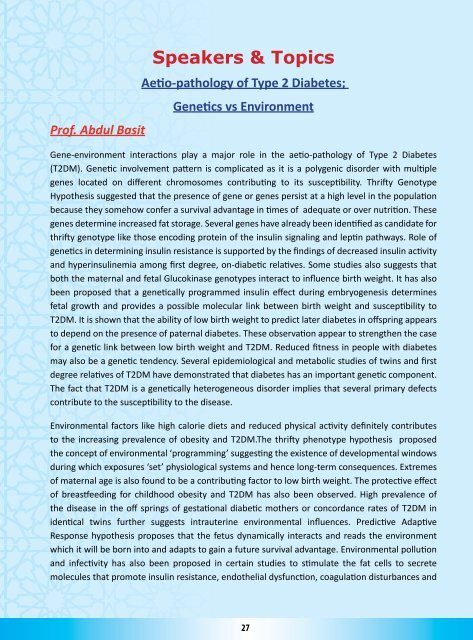Download Booklet - Diabetes in Asia Study Group
Download Booklet - Diabetes in Asia Study Group
Download Booklet - Diabetes in Asia Study Group
You also want an ePaper? Increase the reach of your titles
YUMPU automatically turns print PDFs into web optimized ePapers that Google loves.
Prof. Abdul Basit<br />
Speakers & Topics<br />
Aetio-pathology of Type 2 <strong>Diabetes</strong>;<br />
Genetics vs Environment<br />
Gene-environment <strong>in</strong>teractions play a major role <strong>in</strong> the aetio-pathology of type 2 <strong>Diabetes</strong><br />
(t2DM). Genetic <strong>in</strong>volvement pattern is complicated as it is a polygenic disorder with multiple<br />
genes located on different chromosomes contribut<strong>in</strong>g to its susceptibility. thrifty Genotype<br />
hypothesis suggested that the presence of gene or genes persist at a high level <strong>in</strong> the population<br />
because they somehow confer a survival advantage <strong>in</strong> times of adequate or over nutrition. these<br />
genes determ<strong>in</strong>e <strong>in</strong>creased fat storage. several genes have already been identified as candidate for<br />
thrifty genotype like those encod<strong>in</strong>g prote<strong>in</strong> of the <strong>in</strong>sul<strong>in</strong> signal<strong>in</strong>g and lept<strong>in</strong> pathways. role of<br />
genetics <strong>in</strong> determ<strong>in</strong><strong>in</strong>g <strong>in</strong>sul<strong>in</strong> resistance is supported by the f<strong>in</strong>d<strong>in</strong>gs of decreased <strong>in</strong>sul<strong>in</strong> activity<br />
and hyper<strong>in</strong>sul<strong>in</strong>emia among first degree, on-diabetic relatives. some studies also suggests that<br />
both the maternal and fetal Glucok<strong>in</strong>ase genotypes <strong>in</strong>teract to <strong>in</strong>fluence birth weight. it has also<br />
been proposed that a genetically programmed <strong>in</strong>sul<strong>in</strong> effect dur<strong>in</strong>g embryogenesis determ<strong>in</strong>es<br />
fetal growth and provides a possible molecular l<strong>in</strong>k between birth weight and susceptibility to<br />
t2DM. it is shown that the ability of low birth weight to predict later diabetes <strong>in</strong> offspr<strong>in</strong>g appears<br />
to depend on the presence of paternal diabetes. these observation appear to strengthen the case<br />
for a genetic l<strong>in</strong>k between low birth weight and t2DM. reduced fitness <strong>in</strong> people with diabetes<br />
may also be a genetic tendency. several epidemiological and metabolic studies of tw<strong>in</strong>s and first<br />
degree relatives of t2DM have demonstrated that diabetes has an important genetic component.<br />
the fact that t2DM is a genetically heterogeneous disorder implies that several primary defects<br />
contribute to the susceptibility to the disease.<br />
environmental factors like high calorie diets and reduced physical activity def<strong>in</strong>itely contributes<br />
to the <strong>in</strong>creas<strong>in</strong>g prevalence of obesity and t2DM.the thrifty phenotype hypothesis proposed<br />
the concept of environmental ‘programm<strong>in</strong>g’ suggest<strong>in</strong>g the existence of developmental w<strong>in</strong>dows<br />
dur<strong>in</strong>g which exposures ‘set’ physiological systems and hence long-term consequences. extremes<br />
of maternal age is also found to be a contribut<strong>in</strong>g factor to low birth weight. the protective effect<br />
of breastfeed<strong>in</strong>g for childhood obesity and t2DM has also been observed. high prevalence of<br />
the disease <strong>in</strong> the off spr<strong>in</strong>gs of gestational diabetic mothers or concordance rates of t2DM <strong>in</strong><br />
identical tw<strong>in</strong>s further suggests <strong>in</strong>trauter<strong>in</strong>e environmental <strong>in</strong>fluences. predictive adaptive<br />
response hypothesis proposes that the fetus dynamically <strong>in</strong>teracts and reads the environment<br />
which it will be born <strong>in</strong>to and adapts to ga<strong>in</strong> a future survival advantage. environmental pollution<br />
and <strong>in</strong>fectivity has also been proposed <strong>in</strong> certa<strong>in</strong> studies to stimulate the fat cells to secrete<br />
molecules that promote <strong>in</strong>sul<strong>in</strong> resistance, endothelial dysfunction, coagulation disturbances and<br />
27


